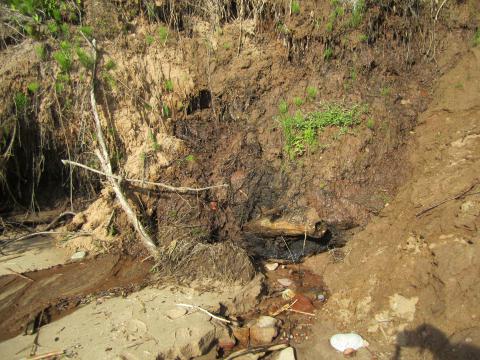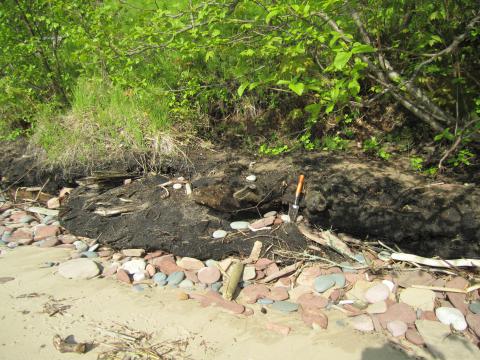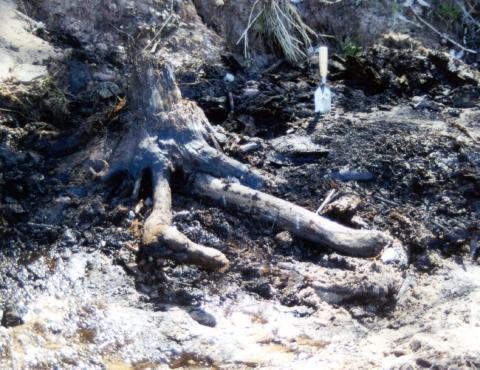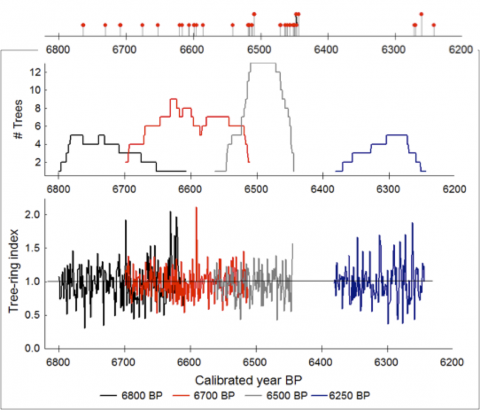• Post-glacial wetlands of southern Lake Superior from 8200 to 6250 cal Yrs BP
• The Houghton Low Stage of the Lake Superior
The discovery of the Elm River buried wood on the shoreline of Lake Superior near Agate Beach belongs to Dr. Steve Shetron. First evidence of exposure of log-filled peat was reported in 1985 at the mouth of Elm River during the low-water stand of the 1980s (Ruotsala and Nordeng, 1987). The most recent low-water stand through 2013 and increased shoreline erosion exposed a new section of the lake shoreline with a thin layer of peat bog (20-50 cm thick) with abundant logs, upright tree stumps and roots appearing in growth position. The peat unit is underlain with beach deposits, which are presently at the water level of Lake Superior (datum 183.2 m asl or 601 ft). The overlying deposits composed of silt, clay and sand are up to 6 m thick. The peat exposure sporadically appears along a 1 km stretch of the Agate Beach. The occurrence of buried wood was monitored since 2009 and then collection of buried wood took place in 2011 and 2012. Size of collected logs varies from 3 cm to 30 cm in radius. The wood was identified as mainly larch and white-cedar with a few ash logs. Eleven radiocarbon dates run on conifer wood and peat show the range of 14C ages from 7260± 45 yr BP to 5476 ±45 yr BP. The greater age of the peat over the wood (7260± 45 yr BP) suggests the possibility of a swamp forming ca. 8090-8160 cal years BP, which was treeless for a while. The earliest evidence for tree growth is dated to 5991 ±31 yr BP, and the latest one at 5476±45 yr BP. The boreal forest existed for almost 700 years starting from a pioneering white cedar stand ca. 6740-6910 cal yrs BP. A century later, larch had mixed into the wetland vegetation indicating a drying soil condition. The age of larch stumps growing on the top of peat suggests that the wetland dried out by 6500-6400 cal yrs BP. The trees were buried by silt deposits at ca. 6250 cal yrs BP. Figure 1 show a composite tree-ring width chronology of larch and white-cedar developed from the Elm River peat wood. No wood found dated to ca. 6400 cal yrs. A 30-50-year gap between two parts of the chronology could indicate a pulse of high water level and conditions reverting to swamp around that time. The dated history of the Elm River wetland corresponds to the middle and later phases of the Houghton Low Stage of Lake Superior. Our dating considerably refines the chronology of the Houghton Low Stage. Based on the Elm River dates alone, the stability of the southwestern shorelines of Lake Superior occurred ca. 6740-6910 cal yrs BP and lasted until ca. 6250 cal yrs BP. A Boreal forest from mixed larch and white-cedar stands established along the shoreline in about one century. The forest was killed by rising water that could be closely linked to a 30.5 m (100 ft.) water level increase during the abrupt transition from the Houghton Low Stage to the Nipissing Stage. Wood evidence from the transition includes bark still present on the stumps, low sample number of wood missing outer rings and with pith rot, stumps, roots in growth position, and reaction wood, which point to the rapid nature of the event submerging the forest stand ca. 6450 cal yrs BP and ca. 6250 cal yrs BP (Fig. 1A).




